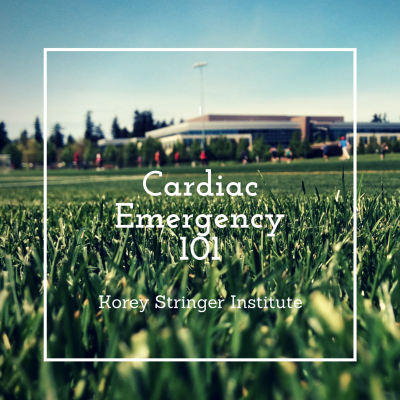By Andrea Fortunati, Assistant Director of Elite Athlete Health and Performance
Sudden cardiac death (SCD) is the primary cause of death in youth sports; however, there is currently no gold standard screening tool for SCD.1 Because of this, basic pre-hospital emergency action plans must be put in place in case of a potentially fatal event.
First, public buildings and locations should have designated areas where an automated external defibrillator (AED) can be readily accessible. The device needs to be maintained by changing the battery and pads when appropriate (i.e., check expiration dates annually). An AED, if maintained and applied appropriately by following the instructions on the device, can be a matter of life or death. The sooner the device is applied from the time of collapse, the greater the chance of survival. For every minute defibrillation is delayed the chance of survival decreases by ~10%.
In the event of a sudden cardiac arrest (SCA), one needs to follow these three rules: (1) call emergency medical services, (2) attach an AED, and (3) perform cardiopulmonary resuscitation (CPR) if certified and qualified to do so. Average arrival time for emergency medical services is estimated to be 8-12 minutes, so the application of an AED is critical for survival.
There are currently two forms of CPR, which include: (1) conventional CPR with 30 compressions to two rescue breaths, and (2) hands-only compression CPR at a rate of 100 beats per minute. Hands-only CPR has been found to be an effective method, and can be performed at the speed of the popular disco song, “Stayin’ Alive.” The conventional method is best utilized for infants, children, anyone found unconscious without a pulse, and those who have collapsed due to breathing problems.2
Regardless of which CPR technique you decide to utilize, any attempt will more than double the likelihood of the individuals’ survival rate.3 Hands-only CPR was suggested in an attempt to increase bystander CPR, which in most cities only accounts for 27-33% of responses.3
AEDs must be applied in the event of a SCA to defibrillate the heart for a chance of survival. Every public location, including outdoor facilities, should have an AED within a close proximity.
When was the last time you checked where the closest AED is located from your practice facility/office/game venue?
References:
- Shabana A, El-Menyar A, Gehani A. Sudden cardiac death in athletes: where do we stand. Crit Pathw Cardiol. 2013;12(3):161-169.
- CPR & First Aid Emergency Cardiovascular Care. Am Heart Assoc. 2015.
- Sayre MR, Berg RA, Cave DM, Page RL, Potts J, White RD. Hands-Only (Compression-Only) Cardiopulmonary Resuscitation: A Call to Action for Bystander Response to Adults Who Experience Out-of-Hospital Sudden Cardiac Arrest A Science Advisory for the Public From the American Heart Association Emergency Cardiovascular Care Committee. Circulation. 2008;117(16):2162-2167.
